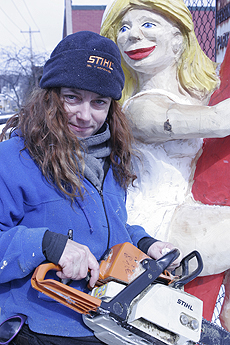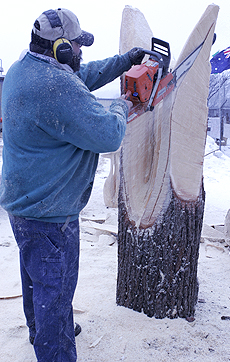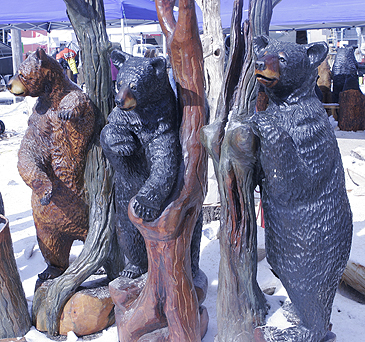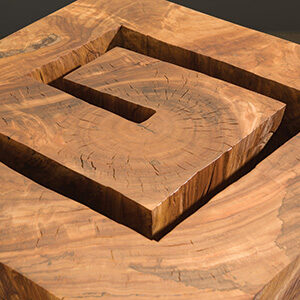On The Road: Chainsaw Woodworking
Pennsylvania's annual chainsaw-carving 'Rendezvous' draws artists with chainsaws from around the world
RIDGWAY, PA.–A droning buzz lures us like bees to a hive, as we follow the sounds of chainsaw carvers through the streets of this small western Pennsylvania town. Forty thousand spectators and I are headed to one of the largest chainsaw-carving event in the world, the Ridgway Chainsaw Carver’s Rendezvous.
There are 227 carvers from nine different countries here, each carving away at a hunk of tree. Sawdust is flying and motors are roaring as we cruise long aisles where carvers are busy bringing wood to life. They’re wrapped in ear protectors, safety glasses, and rugged clothing, making it difficult to distinguish the men from the women. But women are keenly represented here.
These carvers are deeply engrossed in creating anything in the animal kingdom: small simple bears and soaring eagles, to whimsical pieces like Steve Backus’s carving of an “imperfect” male angel who is scratching his butt and smoking. Master carver Angie Polglaze traveled here from Sydney, Australia, to carve one of her “Cheesy Chicks,” a colossal girl with voluptuous breasts, a big butt, big lips, big shoes, and big fun.

Not just for men. Angie Polglaze traveled to the Rendezvous from Sydney, Australia, to carve one of her “Cheesy Chicks.”
Promoting chainsaw art
The first Rendezvous took place here eight years ago. It was the brainchild of Rick and Liz Boni, a husband-and-wife team who wanted promote chainsaw art. Rick had been carving for 20 years when he and Liz saw the need to bring these artists out of the hills to share their knowledge, inspire one another, create stunning art, and share it with the public.
In the first year, only 12 carvers made the journey to Ridgway. Liz told the carvers back then, “If you can get here, we’ll take care of you.” The same holds true now that their numbers soar well above 200.
The Rendezvous has become very much a community passion. Ridgway residents offer up their empty apartments, hunting cabins, even the rectory of the Catholic Church as accommodations. Local organizations like the American Legion and the Eagles donate meals for the carvers. Even private families open their homes to cook massive measls and entertain.
An international affair
All of this occurs despite a frequent language barrier. The nine members of the Japanese team have been learning English so they can communicate with the volunteers who drive them to and from the Pittsburgh airport every year for the event.
There are 17 carvers from Germany. They say mingling with international carvers has changed things for carvers in their country. Before attending the Rendezvous, most chainsaw carvers in Germany used monster-size logging chainsaws, which are more dangerous than the petite tools they now use.
A solo Belgian carver says that he doesn’t know anyone at home interested in chainsaw carving. That’s why he travels so far to attend the Rendezvous.

A family affair. Steve Backus, who says he learned the art from his mother, is part of an extended family of chainsaw carvers.
An evolution in tools
Modern technology and the invention of plastics fast-forwarded chainsaw-carving into a brighter and less painful future. Artists now use unique equipment like petite carving bars and special cutting chains to create their art.
“You don’t have to be Arnold Schwarzenegger in a skirt to do this art,” says Polglaze, whose petite frame stands in contrast to her larger-than-life female carvings. “The tools have become specialized and much lighter. It’s about skill and talent and not so much brute strength and stamina.”
As a result, the field of carvers has expanded to include more and more women and even teenagers. For some, it is a family affair. Forty-seven-year-old Steve Backus learn from his mother, who “really beat it into me, not just taught me,” he chuckles. “She said, ‘If you can carve, you’ll never have to flip hamburgers, you’ll never be hungry, you’ll have a skill and a talent and you can get out of town if you want to’.”
Backus lives with his extended family on a remote island in the Puget Sound in Washington state. His father, brother, sister, and children all carve and make a comfortable living. He is famous for carving stumps in people’s yards–old-growth stumps left from trees that the lumber industry talked them into selling after the spotted owl controversy curtailed logging.
“Stump carving is perhaps the most difficult way to carve with a chainsaw as you never know what you will find inside,” Backus said. An unintended knot or crack can mean changing course mid design. “You’ll have to turn the face because there’s a hole where the nose was to go.”
Backus hits all kinds of stuff in the stump with his saw–nails, bullets, glass, rocks, wagon parts, door hinges, TV antennas, even “Vote for Me” signs.
The carver says he can get a few thousand dollars for a stump carving and has some amazing old-growth cedar to play with in the Pacific Northwest. One elderly couple commissioned him to carve a punky hemlock. “I told them I couldn’t in good graces carve it and take their money, but they said, ‘It’s OK, we’re old, we won’t last long either!'”

Carving the details. Chainsaw carvers use these powerful tools with great precision. However, chisels and hand-held power carvers often find their way into a project.
The art of chainsaw carving
“Softwoods are the wood of choice in chainsaw carving, but preferred species can vary within a state,” says Rick Boni, a Pennsylvania carver. He loves white pine because you can “move a chunk yourself, stand it on end, and not need a forklift.”
Boni’s specialty is “Nature Trees,” where he carves into the tree anything that would be found naturally–squirrels, butterflies, shelf fungus, raccoons nestled inside and woodpeckers hanging on the outside.
Some carvings find a home inside a buyer’s house but if an outside piece is well taken care of, with annual applications of good-quality Marine varnish, Rick says they can remain beautiful for generations.
The trend in this art form is toward more finished work, where artists use chainsaws to block out the piece, but then move to chisel carving, hand tools, even sanders, grinders, and Dremel tools to achieve their desired finishes. Paint is becoming more popular and some of the best pieces are done by artists like Polglaze, who uses stain to dress “her girls” is splashy colors.

The three bears. The carved bear might just be the most popular figure in chainsaw carving.
101 carved bears
Some carvers say if you don’t carve bears, you’re either being obstinate or you aren’t being smart, because this wildlife creature sells better than anything. Some production carvers can crank out dozens a day for $20 each. Other carvers labor over a piece for months (usually not a bear) hoping to sell it for as much as $25,000.
A.J. Lutter from Brainard, Minn., has perfected bear carving. He can put them in any position, make them do anything, make them comical or imposing.
“I think about what makes a bear look cute, or what makes a bear look stupid. I ask myself, ‘What is this bear thinking? Is he half asleep or did a bee just fly up his nose?” A.J. believes you can carve bears all your life and not get bored. The public sure can’t get enough of them.
A spectacular event
The Rendezvous is a spectacle, for there are few sculpture forms as speedy as this. Within 15 minutes of observing an artist at work, the public can see a recognizable form emerge, whether it’s a bear or a Cheesy Chick straddling a rocket as it zooms into space.
The original weekend event has grown into a 10-day affair with close to a dozen workshops. Carvers can learn about finishes, running a business, hand carving, tools and gadgets, and even ice carving. The workshops are held at the Boni’s Appalachian Arts Studio outside of town. The public is invited to the last two days of the Rendezvous, Friday and Saturday, and the event cumulates in an auction on Saturday.
This is the only international chainsaw-carving event that doesn’t offer prize money. Each participant must donate one piece to the auction. The money raised goes to a charity and to help defray the cost of putting on the Rendezvous. Because of the unique nature of the event, carvers rate it as their favorite in the world since it is all about connecting, learning, sharing, inspiring, and giving back. That makes the event all the more powerful, and hence, successful.
Event coordinator Liz Boni planned it that way and wants to keep it that way. “You really have to come to the Rendezvous to believe it. There is such creative energy. It’s difficult not to catch a buzz, so to speak!”
Cindy Ross is a freelance writer and photographer in New Ringgold, Pennsylvania.






















Comments
The pdf link is broken. There is no downloadable pdf file. The magazine reference is also incorrect. Please fix this longstanding problem.
Log in or create an account to post a comment.
Sign up Log in